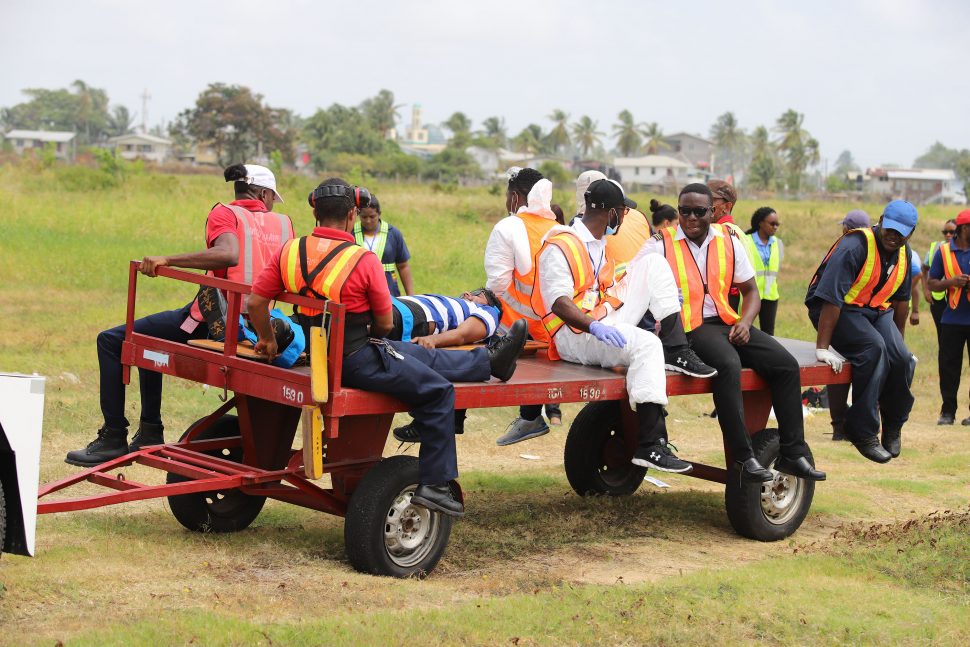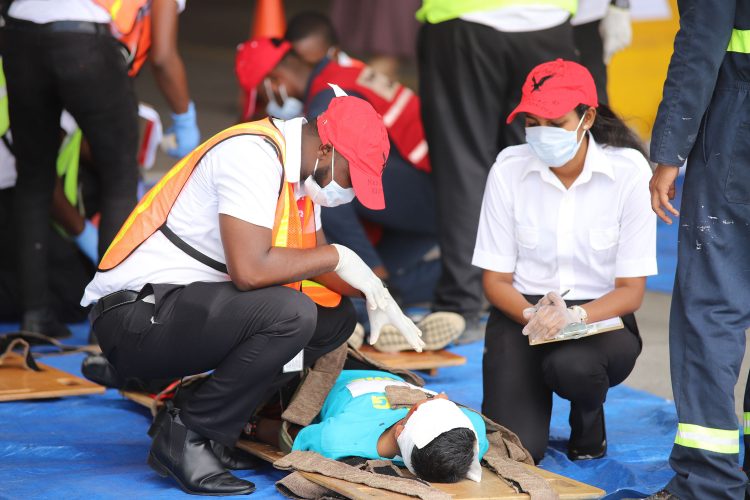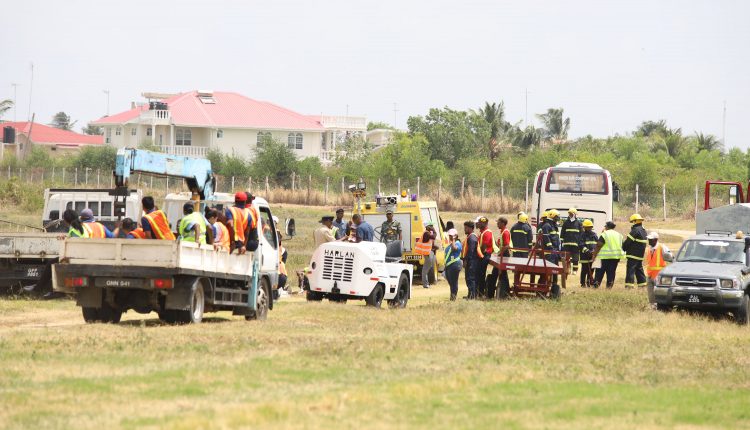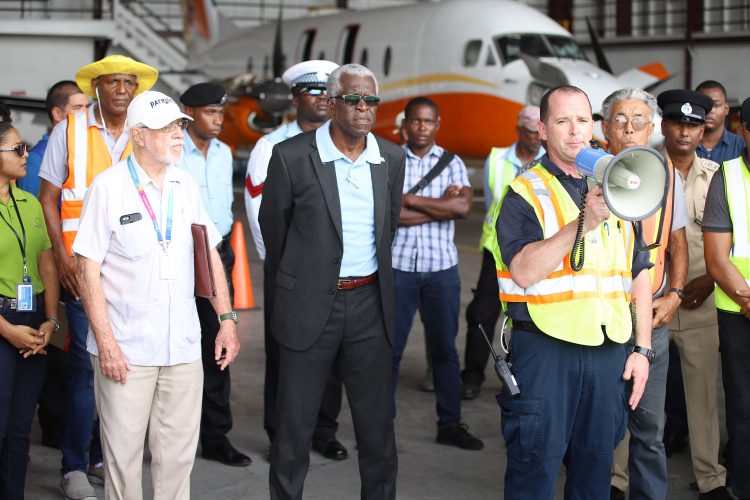The Eugene F. Correia International Airport (EFCIA) at Ogle staged a full-scale Mass Casualty Incident Management simulation exercise on Friday, exposing staff members to procedures that should be followed in the event of an emergency there.
The exercise, deemed necessary for airport authorities to determine where serious gaps may exist in its current emergency plan, saw airport personnel and agencies being credited for performing “exceptionally well.”
“This test will correct as many deficiencies as possible and familiarise all personnel and agencies concerned with the airport environment and [external] agencies [with] their role in the airport emergency plan,” William Sanasee, Safety and Compliance Manager at the EFCIA, explained.
The scenario played out involved an ATR 72 aircraft, which is the largest type of plane operating at the airport and used by Liat and Caribbean Airlines. In the simulation, the aircraft overruns the runway on landing and catches on fire at the end of the runway, causing injuries to passengers. In the scenario, 48 passengers were aboard the plane, three persons were critically injured while 15 sustained minor injuries as a result of the crash.
About three to four minutes after the simulated crash occurred, the fire brigade stationed at the airport arrived at the crash site located at the eastern end of the runway.
Response vehicles subsequently raced onto the runway in the direction of where the crash would have occurred. First responders, who were trained in administering first aid, rushed to the scene and tended to the injured, who were taken to the airport’s emergency response medical station at the Air Services Limited hangar. There, the passengers were classified according to injuries sustained via triaging. Those with serious injuries, after a medical examination by nurses and paramedics, were transported to hospitals while the rest of the passengers were treated at the triage zone.
Police ranks were observed manning the cordon at the exercise’s crash site. Additionally, as the stimulation played out at the aerodrome, staff were informed of a surprise element of a ‘bomb threat’ in the terminal building at the departure lounge. In this scenario, nine persons were held hostage and the bomb squad for the Guyana Police Force (GPF) had responded, Sanasee explained.
After 65 minutes, the operation, which was observed by Director General of the Guyana Civil Aviation Authority Egbert Field, along with other officials, concluded. Other evaluators included personnel from the Board of Health, the Civil Defence Commission, the airport officers and observers from the GPF and the Guyana Fire Service (GFS), along with airport operators.
The simulation was directed by visiting US fire-fighting instructor and technical rescue consultant Jack McGovern, who has been working with the authorities at Ogle since 2006. He told participants that he was “pleased to say not only the OAI (Ogle Airport Incorporated) performed exceptionally well in response to the mass casualty response, they also performed exceptionally to the additional bomb threat that was put in place.”
McGovern, in his review, deemed the exercise a success and highlighted that communication among the integrated units was significantly improved when compared to past years. “The improvement we have noticed…results from communication. We have always had issues of communication in the past and it has seemed this year we have significant improvement,” he said while adding that he observed “there was teamwork with the integrated agencies. There seems to a seamless effort among the group and that in turn, resulted from the success of the exercise.”
He added that there were some challenges with regards to the surprise “bomb threat.” McGovern said while he was satisfied with the response towards the threat, it was evident that there were some challenges.
“Some challenges that were observed were preparing for a bomb threat, responding and reacting. We stopped that portion of the exercise because it is obviously a long drawn out process,” he disclosed.
Nonetheless, he indicated that “everyone responded appropriately, and I think they are coming away with things they can incorporate into their plan and deal with in the future and I look forward to seeing that next year.”
He, however, urged staff to keep working and keep the lessons learnt from the exercise at the back of their minds.
“When we say an exercise is a success, it doesn’t mean we get to rest on our heels; never settle for okay. Okay is not okay…” he emphasised before calling on staff members to always continue to strive to do better. “I think if we can keep that at the back of our mind, we can always continue to make Ogle airport at the top of their game…,” he said in conclusion.
Field, in his brief remarks to participants, said the simulation was “nicely executed and we will now discuss with the coordinators and look over details, see if there were any comments or items that needs to be addressed.”
He noted that while the response from the participating units was favourable, it can be better.
“Within three to four minutes, the fire service was out there… from my vantage point in the tower, the response time was in concurrence of standard operating procedure… It was good, but it can be better,” he noted.
He said from the position he was in, he was able to observe the delivery of service of every unit and observed every unit being able to “conduct themselves in an admirable manner and I will like to say continue the good work. There are always items we can improve on no matter how good it was.”
An exercise of this magnitude, Field pointed out, “does not involve one unit, it involves a number of units and departments and those units and departments have got to be coordinated…I concur the exercise was a good exercise.”
Apart from EFCIA Emergency Operation Centre staff, Airport Security and first responders, such as the GFS, the GPF, the Guyana Defence Force, ambulance and medical services, as well as major hospitals in the city, including the Georgetown Public Hospital, Mercy Hospital and Woodlands Hospital, participated in the exercise.
The exercise is required to be conducted by the airport to ensure that its operators maintain and operate the aerodrome in accordance with the standards and recommended practices of the International Civil Aviation Organization (ICAO). The GFS is required to provide rescue and fire-fighting services at, and in the vicinity of the airport, in accordance with ICAO’s regulations.













